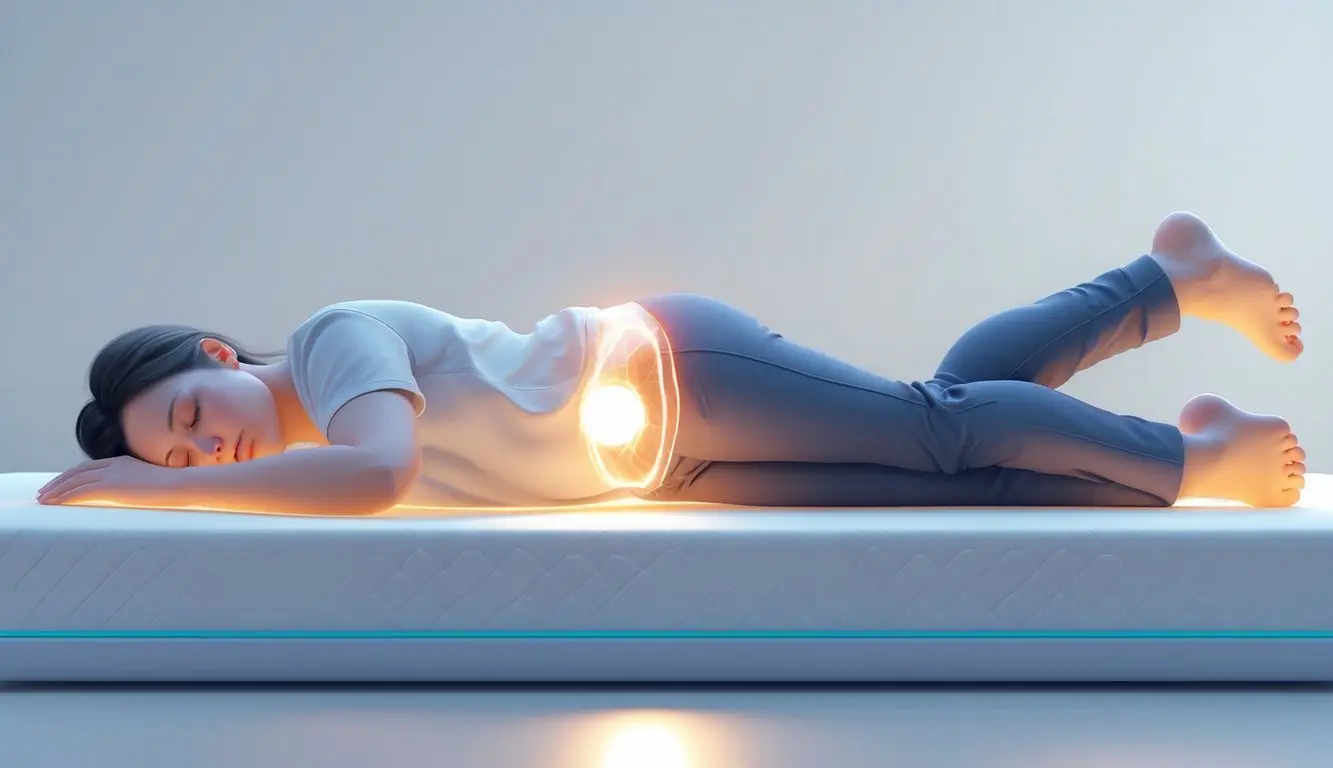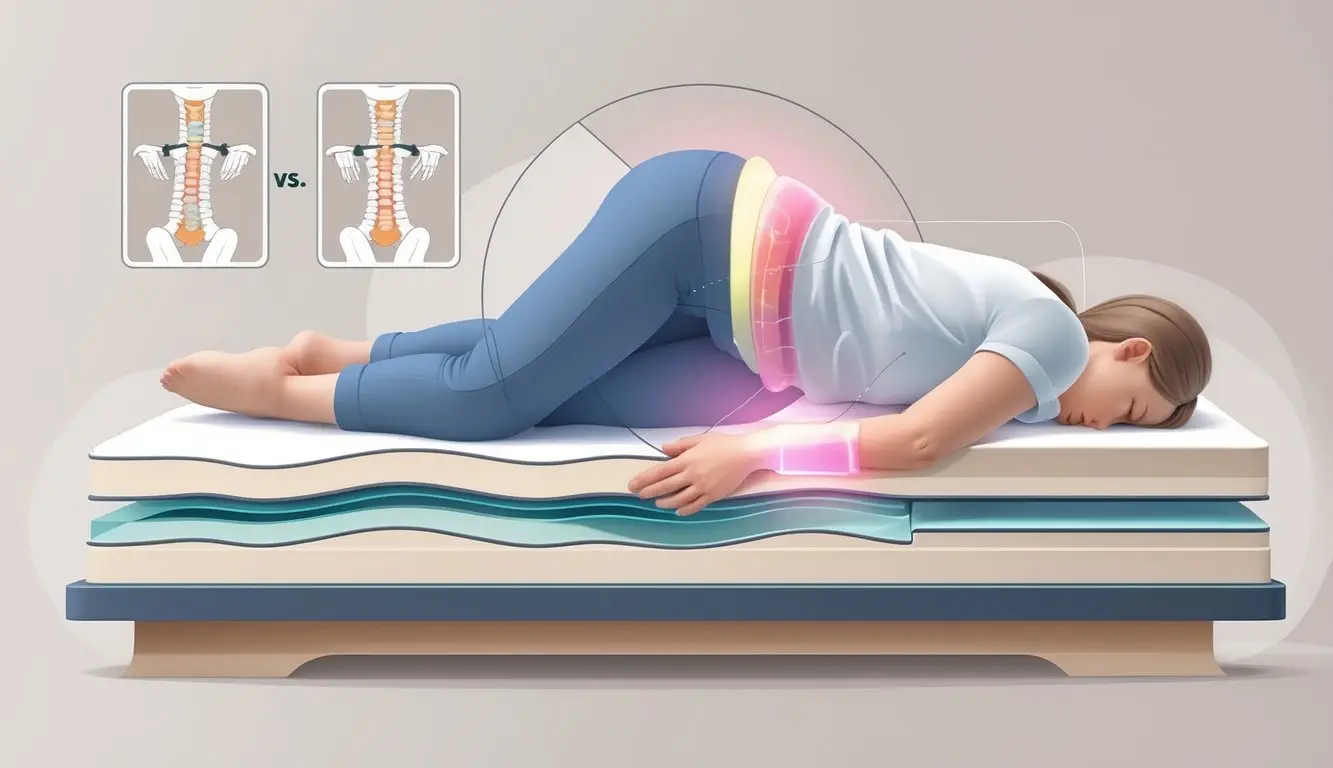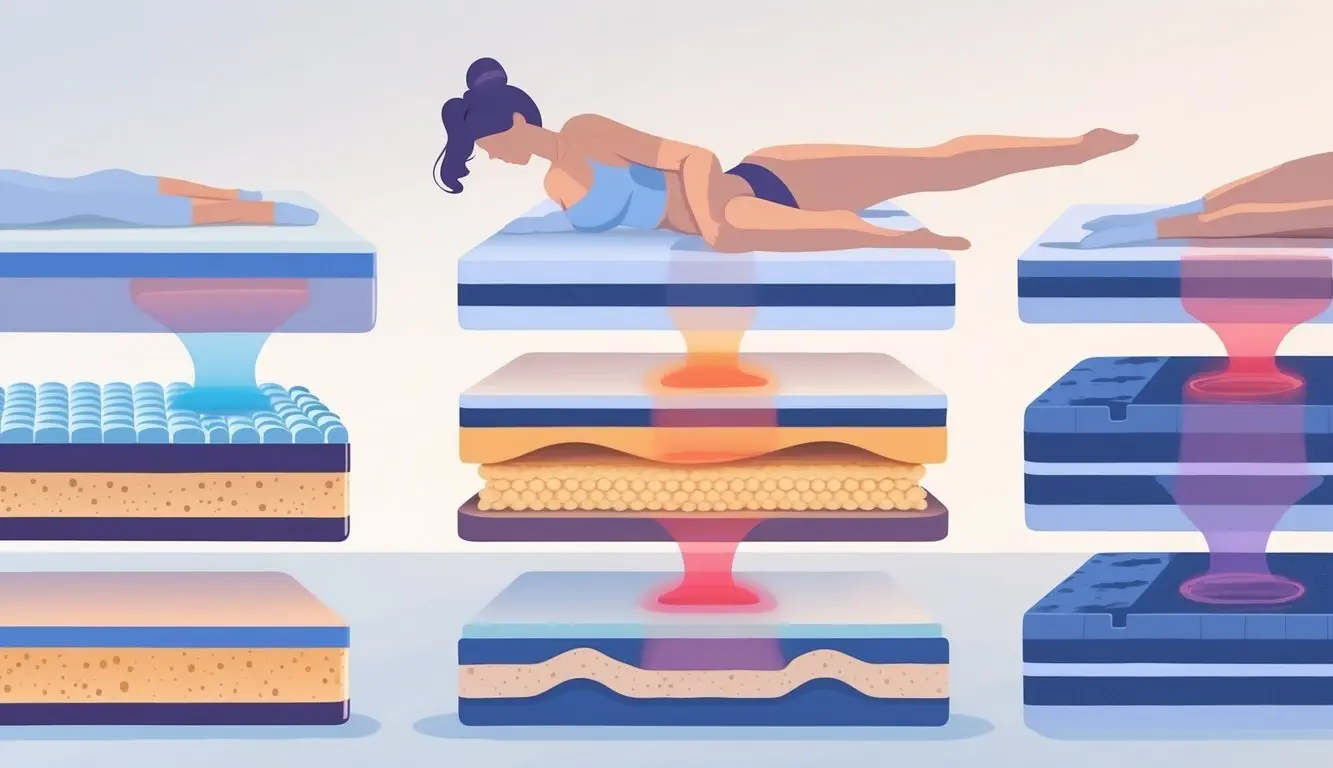Many people wake up with sore hips and wonder where the pain is coming from. They may not realize that their mattress could be a major factor in their discomfort. Yes, a mattress can cause hip pain if it does not give enough support or is too firm or too soft.

Mattresses that do not match a person’s body and sleep style can lead to pressure on the hips. This is more common for people who sleep on their sides, as more weight is placed on the hip joints.
Understanding the connection between a mattress and hip pain can help people find relief and enjoy better sleep. Choosing the right mattress may make a big difference in how a person feels when they wake up each morning.
Can a Mattress Cause Hip Pain?

Mattress quality can affect how a person sleeps and whether they wake up with hip pain. Knowing the signs can help people tell if their mattress is to blame.
How Mattress Quality Affects Hip Pain
Mattresses that are too firm or too soft can both cause hip pain. A firm mattress may not let the hips sink in enough, putting extra pressure on the joint. A soft mattress may let the hips sink too far, making the spine bend in an unnatural way.
Materials matter as well. Memory foam can provide good support for hips because it shapes to the body. Innerspring mattresses may not always give enough cushioning for people with hip pain.
Key points to consider:
- Firmness Level: Medium-firm mattresses often give the most relief for hip pain.
- Mattress Age: Old mattresses can lose their support and cause discomfort.
- Body Weight: Heavier people may need firmer mattresses for proper support.
Key Signs Your Mattress May Be the Cause
There are some signs that show a mattress could be behind someone’s hip pain.
Waking up with hip stiffness or soreness is common. If hip pain gets better during the day but returns after sleep, this points to the bed as the problem. New or worsening pain after getting a new mattress may also be a clue.
Look for:
- Visible sagging or lumps in the mattress.
- Pain that goes away after sleeping elsewhere, such as in a hotel or on a different bed.
- Needing to adjust position often at night to get comfortable.
Checking these signs can help someone decide if they need to replace their mattress.
Common Mattress Types and Their Impact on Hip Pain

Mattress materials and design affect how well a mattress supports the hips. Some types provide more even weight distribution, while others may create pressure points or lack support.
Memory Foam and Hip Pressure Relief
Memory foam mattresses shape themselves around the body. This helps spread weight evenly and reduces pressure on the hips.
People with hip pain often choose memory foam because of its ability to cradle sore spots. The foam responds to heat and body shape, so heavier areas like the hips sink in slightly and get cushioned.
A contouring mattress like memory foam can help keep the spine straight. This may lessen pain for people who sleep on their side or back. However, if the foam is too soft, it can allow the hips to sink too much, which may cause the lower back to dip and add discomfort.
Not all memory foam is the same. Denser foam usually offers more support and lasts longer, while softer foam may break down faster and become uneven.
Key points about memory foam:
| Pros | Cons |
|---|---|
| Good pressure relief | Can trap heat |
| Spinal alignment | Soft foam may sag |
| Cradles sore areas | Less bounce |
Latex Mattresses: Benefits and Drawbacks
Latex mattresses are made from natural or synthetic rubber. They are known for being springy and supportive, which can help with hip pain if the mattress is the right firmness.
Latex spreads weight well but resists sinking in too deeply. This keeps the hips level with the rest of the body and avoids misalignment.
Latex is also breathable, so it tends to sleep cooler than most memory foam. People with allergies sometimes choose natural latex because it resists dust mites and molds.
There are a few drawbacks. Latex mattresses often cost more than other types. Some people find them too firm, which might increase pressure if they sleep on their side and the mattress does not have a softer comfort layer.
Quick facts about latex:
- Even support
- Sleeps cool
- Natural and synthetic options available
Innerspring Mattresses and Support
Innerspring mattresses use metal coils for support. The coils can be arranged in different patterns and often have a layer of foam or fiber on top.
These mattresses are easy to find and tend to feel bouncier than foam or latex. Innerspring mattresses can be good for people who like a firmer sleep surface.
However, standard innerspring mattresses may lack enough cushioning for the hips. If the top comfort layer is thin, it can create pressure points that cause or worsen hip pain.
Edge support is usually strong, which helps prevent sagging over time. The amount of support and comfort can vary depending on coil count, coil type (like pocketed or continuous), and the thickness of the top layer.
Table: Innerspring Features
| Feature | Description |
|---|---|
| Support | Good, but may feel firm |
| Pressure Relief | Depends on top layer |
| Durability | Varies by model |
Hybrid Mattresses: Combining Comfort and Stability
Hybrid mattresses mix two or more materials, usually combining innerspring coils with a layer of memory foam or latex on top. This design tries to give both support and cushioning, which can help reduce hip pain.
The foam or latex layer helps absorb pressure around the hips, while the coils underneath provide structure. Many hybrids use pocketed coils, which move separately and support the body’s shape more closely.
Hybrids are made in different firmness levels. Some offer more firmness for back sleepers, while others give a softer feel for side sleepers who need extra hip relief.
Hybrid mattresses often have better airflow than solid foam beds, helping keep the surface cooler. The extra features and layered build mean hybrids usually cost more than all-foam or simple spring models.
Hybrid benefits:
- Combines pressure relief and support
- Good for different sleep styles
- Less heat buildup
Key note: The exact feel depends on the type and thickness of each layer used in the hybrid.
Optimal Mattress Firmness for Hip Health

Mattress firmness plays a direct role in hip support and pressure relief. The right choice helps keep the hips, spine, and shoulders in healthy alignment during sleep.
Medium-Firm Mattresses: Balancing Support and Comfort
A medium-firm mattress is often recommended for those with hip pain. This firmness level offers enough support to keep the hips from sinking too far into the bed. At the same time, it has enough cushion to relieve pressure on the hip joint.
Sleeping on a medium-firm mattress helps the body stay in a stable position. The spine, hips, and shoulders stay in line, reducing the chance of strain. This can prevent both new pain and make current hip discomfort less severe.
Some studies show that people with lower back or hip pain often report better sleep on a medium-firm surface compared to a soft or hard one. For sleepers who change positions, medium-firm mattresses provide good support for both side and back sleepers.
Risks of Too-Soft or Too-Firm Mattresses
A mattress that is too soft may cause the hips to sink down too much. This can twist the spine out of alignment and lead to pain in the hip and lower back. People who sleep mostly on their sides are at higher risk when using overly soft mattresses.
On the other hand, a very firm mattress does not provide enough cushion for bony areas like the hips. The lack of contouring can lead to pressure points, causing discomfort and even numbness over time.
Comparing mattress firmness levels:
| Firmness Level | Hip Support | Risk of Pressure Points | Spinal Alignment |
|---|---|---|---|
| Soft | Low | Low | Poor |
| Medium-Firm | Medium-High | Medium | Good |
| Firm | High | High | Fair to Poor |
Choosing a mattress with balanced firmness is important for keeping the hips healthy and pain-free during sleep.
Sleeping Positions and Hip Pain
The way a person sleeps can affect hip comfort and pain. The right mattress may help reduce pressure, but sleeping position also plays a key role for side and stomach sleepers.
Side Sleeping and Hip Stress
Side sleepers put more direct pressure on the hip and shoulder that touch the mattress. If the mattress is too firm, it may not let the hip sink in, pushing it up and causing discomfort. This can lead to pain or stiffness in the hip and even back pain in the morning.
On the other hand, a mattress that is too soft may let the hip sink too much, causing the spine to bend out of line. Maintaining a straight spine is important for side sleepers to avoid pain, especially in the lower back and hip. Using a pillow between the knees can also help improve hip alignment.
A medium or medium-soft mattress usually works best for most side sleepers. Materials like memory foam can cushion points where the body presses into the bed. This reduces stress on the hip and helps keep the spine healthy.
Back and Stomach Sleepers: Different Risks
Back sleepers usually spread their weight more evenly, which can help lower the risk of hip pain. However, if the mattress sags too much, the hips may sink deeper than the rest of the body. This can misalign the lower back and lead to discomfort.
Stomach sleepers often face more problems. Their hips can press deeply into the mattress, pulling the lower back out of its natural curve. This increases the chance of both hip and back pain, especially on a soft mattress.
For these positions, a medium-firm to firm mattress is usually better. It keeps the hips level with the rest of the body. Some back and stomach sleepers also use a thin pillow under the hips to support the spine and reduce stress on the lower back and hip area.
Other Factors That Can Contribute to Hip Pain

Certain mattress features may lead to hip pain, but other elements in your sleep environment can also make a difference. Paying attention to the age of your mattress and the types of pillows or toppers you use can affect not just hip pain, but comfort and health during sleep.
Effects of Mattress Age and Sagging
A mattress that is old or sagging may cause hip pain by failing to support the body’s natural alignment. Over time, springs and foams break down, making the mattress less able to hold up areas like the hips or lower back.
Some signs of a worn out mattress include:
- Visible dips or soft spots in the surface
- Feeling like you “roll” to the middle at night
- Waking up with new pain, including hip or back discomfort
A sagging mattress can also push the spine out of its natural shape. This pressure on the hips and lower back increases the risk of waking up stiff or sore. Most mattresses last about 7-10 years, but some may need replacing sooner if sagging appears.
How Pillow and Mattress Topper Choices Matter
Pillow height and mattress toppers can affect the body’s alignment during sleep. A pillow that is too high or too low may strain the neck, and this can lead to pain not only in the neck but also down the back and hips.
For those who sleep on their side, a soft pillow between the knees can reduce pressure on the hips. A high-quality mattress topper can add extra comfort or support to a mattress that feels too firm or too soft.
Latex or memory foam toppers are popular options because they can contour to the body’s shape. However, a topper that is too thick or too thin may not solve the problem and can even make hip pain worse. It’s helpful to try different combinations to see what gives the best relief.
How to Alleviate Hip Pain Caused by Your Mattress

Some mattresses can add pressure to the hips and make pain worse, especially if they are too soft or too firm. Certain changes to sleep habits and mattress choices may reduce pain and help someone get a good night’s sleep.
Choosing the Right Mattress for Your Needs
Picking the right mattress is important for hip comfort. A mattress that is too firm can put more pressure on the hips, while one that is too soft may not support the body well. Medium-firm mattresses often balance comfort and support for most people.
People who sleep on their side should look for mattresses with extra pressure relief, such as those made with memory foam or a soft pillow top. Those who sleep on their back may prefer a slightly firmer surface.
It helps to try out mattresses in-store or choose brands that offer free trials and easy returns. Many companies let buyers test the mattress at home for 30–100 days. If pain improves with a new mattress, it could mean the old one was the problem.
Mattress Types and Features
| Mattress Type | Good for Hip Pain? | Notes |
|---|---|---|
| Memory Foam | Yes | Relieves pressure on joints |
| Latex | Yes | Supportive and firm, limits sink |
| Innerspring | Sometimes | May need a topper for cushioning |
| Hybrid | Yes | Mixes support and pressure relief |
Improving Sleep Hygiene for Better Hip Health
Good sleep habits can lower hip pain. Keeping a regular bedtime and wake time helps the body rest and heal. Changing sleep positions may help, too. Sleeping with a pillow between the knees can keep the hips in line and relieve pressure.
Stretching before bed can relax tight hip muscles. Gentle moves, like pulling the knees to the chest or doing hip stretches, can improve comfort.
Other small changes, such as keeping the bedroom cool and dark and limiting screen time before bed, can make it easier to fall asleep and stay asleep. Better sleep helps the body recover and may lessen pain over time.
Frequently Asked Questions

Certain mattress types and features may have a direct impact on hip pain. Sleeping position and ways to adjust current beds also play an important role in hip comfort.
What type of mattress is recommended for alleviating hip pain?
Medium-firm mattresses are often recommended for people with hip pain. They offer support while also providing some cushion to relieve pressure on the hips. Mattresses with good contouring help keep the spine in alignment.
Can memory foam mattresses contribute to hip discomfort?
Memory foam mattresses can sometimes cause hip discomfort if they are too soft or too firm. A mattress that is too soft may let the hips sink too much, causing misalignment. If the memory foam is very firm, it might not provide enough cushioning for the hips.
How can I modify my current mattress to reduce hip pain?
Adding a mattress topper made of memory foam or latex can help improve comfort. Rotating the mattress every few months may also even out wear and help with hip pain. Using extra pillows for support can relieve pressure as well.
Are there specific mattress features that benefit individuals with sciatica and hip pain?
Mattresses that offer zoned support or targeted pressure relief are helpful for people with sciatica and hip pain. Features like extra support at the hips or softer material at the shoulders can improve alignment. Good edge support also helps with overall comfort.
Why might a new mattress cause hip pain?
A new mattress might feel too firm or too soft at first and can place pressure on the hips. It may take a few weeks for the body to adjust to a new sleeping surface. Sometimes, the mattress does not suit the sleeper’s body type or sleeping position.
What sleeping positions are recommended for preventing hip pain?
Sleeping on the back or the non-painful side with a pillow between the knees may reduce hip pain. Stomach sleeping can put extra pressure on the hips and is usually not advised. Side sleepers should use a supportive mattress and keep their knees aligned.